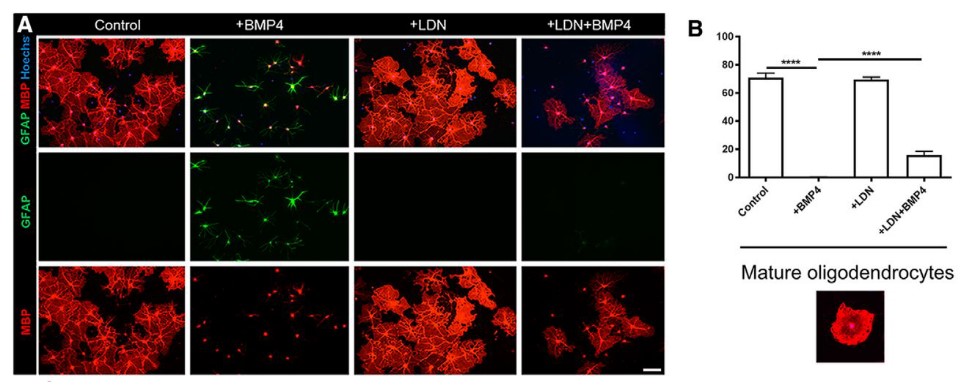Inhibiting Inhibitory Factors to Promote Remyelination
Claudia Lopez-Lloreda is currently a graduate student in Neuroscience at University of Pennsylvania, PA. Follow them on Twitter @claulopezneuro
Myelination by oligodendrocytes is important for optimal neuronal function. This is evidenced by central demyelinating diseases such as multiple sclerosis in which the myelin sheath is degraded. Although remyelination can occur to some extent, inhibitory factors present in the microenvironment of demyelinated lesions often prevent complete functional recovery of damaged nerves. Such inhibitory factors include the bone morphogenetic protein (BMP) family, a group of 20 secreted proteins. Previously, it was shown that BMP4 signaling inhibits oligodendrocyte differentiation in vitro and that blocking BMP4 signaling promotes remyelination in the cuprizone-induced mouse model of in vivo demyelination. BMP4 can bind to BMP type I receptors (BMPRI) BMPRIA and BMPRIB; ligand binding stimulates phosphorylation of downstream SMAD1/5/8 transcription factors. However, it was not known through which receptor(s) and pathways BMP4 acts to exerts its inhibitory effects on remyelination. In their eNeuro publication, Govier-Cole and colleagues examined which cells in the oligodendrocyte differentiation pathway are affected by BMP4 signaling and via which BMP receptors and downstream proteins is the remyelination process impaired.
Female mice, ~2 months of age, were fed a cuprizone-supplemented diet for five weeks to induce demyelination in vivo; control mice received a non-supplemented diet throughout the experiment. Subsequently, some cuprizone-treated mice underwent a recovery period in which they were fed a non-supplemented diet so that the remyelination process would commence. The authors used immunohistochemistry and spectral confocal reflection imaging to assess myelination changes in the corpus callosum. Cuprizone treatment for five weeks led to decreased myelination, as expected. Following seven days of recovery, cuprizone-treated mice received intracerebroventricular infusions of either vehicle control or LDN-193189, an inhibitor that selectively blocks SMAD1/5/8 phosphorylation. LDN-193189 infusion led to a significant increase in the percentage of myelinated area in the corpus callosum compared to vehicle-infused mice. Therefore, remyelination was enhanced when BMP4/BMPRI signaling was selectively blocked. Furthermore, blocking BMP4/BMPRI signaling promoted oligodendrocyte differentiation but did not affect astrocytes or microglia, which also express BMP4. These results suggest that BMP4/BMPRI signaling regulates oligodendrocyte differentiation, and consequently remyelination, after cuprizone-induced injury.
To identify which oligodendroglial cells were subject to the pharmacological effects of LDN-193189-induced differentiation, the authors looked at the differentiation of primary mouse oligodendrocyte precursor cells in vitro; all cells were exposed to triiodothyronine to induce differentiation. Exposure to BMP4 only resulted in a decreased number of mature oligodendrocytes, an increased number of astrocytes, and inhibited the degree of myelination in co-cultures with dorsal root ganglion neurons. However, when cultures were pre-treated with LDN-193189, oligodendrocyte maturation and myelination were promoted, and astrogliogenesis was blocked, suggesting that BMP4 exerts its inhibitory effects through BMPRI (Figure 1). To examine the potential molecular mechanisms of this process, the authors performed qRT-PCR and found that gene expression of ld4, a transcription factor known to inhibit oligodendrocyte differentiation, was upregulated in oligodendrocyte precursor cells in response to BMP4 exposure in vitro. Interestingly, this was again blocked by LDN pre-treatment, indicating that BMP4 acts through BMPRI to activate downstream targets such as ld4 that inhibit oligodendrocyte differentiation.

To determine whether remyelination-related effects of BMP4 are mediated via one or both BMPRI receptors, the authors used the Pdgfra promoter to conditionally knock out BMPRIA exclusively in oligodendrocyte precursor cells, which express BMPRIA at higher levels than BMPRIB. Oligodendrocyte precursor cells isolated from control BMPRIA-expressing mice had decreased oligodendrocyte differentiation and enhanced astrogliogenesis in response to BMP4 exposure. Interestingly, in oligodendrocyte precursor cells in which BMPRIA was knocked out, more oligodendrocytes were able to reach maturity after BMP4 exposure. Further, in co-cultures with dorsal root ganglion neurons, knocking out BMPRIA in oligodendrocyte precursor cells resulted in increased myelin protein production and enhanced myelination of neurons. These results suggest that BMP4 signaling specifically through BMPRIA mediates the inhibitory effect on oligodendrocyte differentiation, and consequently, on remyelination.
These findings elucidate an important mechanism of inhibition of remyelination. Additionally, this points to a mechanism that could potentially be targeted to enhance remyelination in demyelinating diseases such as multiple sclerosis.
This Reader's Pick was reviewed and edited by eNeuro Features Editor Rosalind S.E. Carney, D.Phil.
Read the full article:
Inhibiting Bone Morphogenetic Protein 4 Type I Receptor Signaling Promotes Remyelination by Potentiating Oligodendrocyte DifferentiationAlistair E. Govier-Cole, Rhiannon J. Wood, Jessica L. Fletcher, David G. Gonsalvez, Daniel Merlo, Holly S. Cate, Simon S. Murray and Junhua Xiao
FOLLOW US
POPULAR POSTS
TAGS
CATEGORIES


 RSS Feed
RSS Feed




